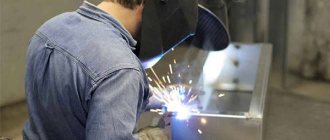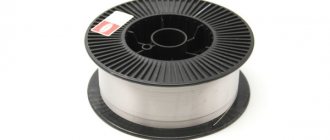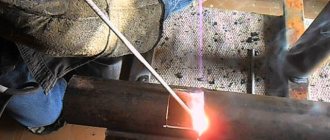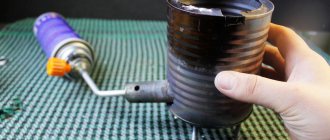Why is it necessary to weld aluminum to steel?
Aluminum (and its alloys) are much lighter than steels, with a density of about 2.70 g/cm3, compared to a range of 7.75 to 8.05 g/cm3 for steels. This means that a comparable volume of steel is approximately three times heavier than aluminum.
Many industries use steel for a variety of structural applications. However, due to the density of steel, there is a significant weight loss associated with its use.
New environmental laws are forcing the transportation industry to comply with strict limits on greenhouse gas emissions. One way to reduce emissions is, for example, to reduce the weight of the vehicle structure. The replacement of various steel structures with aluminum alloys is currently of great industrial importance. In many cases, it is not always possible to replace the entire steel structure with aluminum alloys, so it is necessary to combine the two materials.
Aluminum alloys can be joined to steels relatively easily using methods such as adhesive bonding, mechanical fastening or soldering.
But when superior structural integrity is required, welding is preferred. However, welding aluminum alloys to steel is difficult.
Why is aluminum difficult to join with steel?
Aluminum alloys and steel differ greatly in metallurgy and physical properties such as thermal conductivity and melting point. Typically, steel's melting point is around 1370°C, more than twice that of aluminum, which melts at around 660°C.
Apart from their widely varying melting points, each of these metals is virtually insoluble in the other. When molten, they react to form brittle intermetallic phases. It is understood that the above problems may present problems in fusion welding such as arc welding of steel and aluminum.
The resulting welded joints will have poor properties and, due to their brittle nature, are often undesirable for many industrial applications.
Welding aluminum using fluxes
Fluxes for welding aluminum have been used for a long time. They are represented by a wide range of models, where there are materials for different aluminum alloys. Their main purpose is to destroy the oxide film. When heated, the applied flux dissolves and destroys the oxide, and the two elements are immediately connected.
Manufacturers offer fluxes that are used only in gas welding of aluminum, or only in arc welding. In the latter case, graphite or carbon electrodes are used.
How do you join aluminum to steel?
It is well known that the use of fusion welding processes to join steel to aluminum is difficult due to differences in melting points, thermal conductivity, expansion coefficients and the tendency to form brittle intermetallic compounds. Since the solubility of Fe in Al is very low (about 0.04 wt%), at temperatures >350 °C, when the diffusion of Fe in Al becomes significant, precipitation of Fe-Al intermetallic compounds begins. Significant intermetallic precipitation can occur well below the melting point of aluminum (660 °C for pure Al). The exact degree of precipitation of intermetallic compounds is determined by diffusion and depends on the time and temperature limit of interaction between the interacting Fe and Al boundaries.
Gas
Aluminum cannot be boiled in air . The weld pool must be protected with inert gas. For “black” steel this is not necessary; the flux with which the consumable electrode is coated is sufficient, but for aluminum this circumstance plays an important role.
Argon is usually used, less often helium, which has an excellent effect on the entire process and melting features, but is also much more expensive. Argon is used more often, but please note that it must be technically pure and the content of foreign impurities is minimal. Bad argon will produce a dirty seam with inclusions.
Using lasers to create a solder joint
Using lasers to create a solder joint between steel and aluminum is a logical step, as the high heat intensity in a small area generated by a laser means that a stable soldering environment can be created locally and quickly moved to create a joint with minimal time for diffusion to control excessive formation of intermetallic compounds.
The Fe-Al phase diagram shows the range of solid intermetallic phases that can be formed, namely; Fe3Al (892HV), FeAl (470HV), FeAl2 (1060HV), Fe2Al5 (1013HV) and FeAl3 (892HV).
These phases are characterized by extremely high hardness, almost zero ductility and very low fracture toughness. Therefore, if a thermally produced joint between steel and aluminum must contain some or all of these phases,
The thickness of the intermetallic compound layer should be as thin as possible to achieve good mechanical properties in the joint. You can check the welding here using Agfa D7 x-ray film from the company; on thin parts you can use Agfa D2 x-ray film.
Certain practices must be adopted when arc welding steel and aluminum to avoid the formation of an intermetallic compound. The first is to use an aluminum coating on the steel. This can be achieved by dipping the steel into molten aluminum (hot aluminizing). Once the aluminum is applied, the aluminum can be welded to the aluminum coating. Care must be taken to ensure that the arc does not heat the coated aluminum to excessive temperatures, otherwise an intermetallic compound may form. The first is to use an aluminum coating on the steel. This can be achieved by dipping the steel into molten aluminum (hot aluminizing).
Once the aluminum is applied, the aluminum can be welded to the aluminum coating. Care must be taken to ensure that the arc does not heat the coated aluminum to excessive temperatures, otherwise an intermetallic compound may form.
The first is to use an aluminum coating on the steel. This can be achieved by dipping the steel into molten aluminum (hot aluminizing). Once the aluminum is applied, the aluminum can be welded to the aluminum coating. Care must be taken to ensure that the arc does not heat the coated aluminum to excessive temperatures, otherwise an intermetallic compound may form.
Welding aluminum and steel with intermediate metal coating on steel edges
To improve the welding process, technological techniques are used that ensure the melting of aluminum rather than steel. For example, before welding begins, the edges of the steel are coated with various metals, which are applied hot or galvanically. Argon arc welding with a tungsten electrode is performed on these coatings using filler wire. Good welding results are also obtained by electroplating the edges.
The simplest method of coating the edges with an intermediate metal is the hot aluminizing method. Its essence consists of dipping steel edges into molten aluminum, holding it in it for 40 minutes and then slowly cooling. But practical experiments carried out by the Leningrad Ship Institute (now St. Petersburg State Marine Technical University) and the Electric Welding Institute named after E.O. Paton showed the feasibility of other metals, or the use of bimetallic inserts.
The choice of coating depends on the strength requirements for the welded joint. In addition, economic feasibility is also taken into account. The most expensive method is the electroplating method.
For argon arc welding (TAW) of AD1 alloy with steel, tin is most suitable as a coating for steel edges, which is applied by galvanic or hot-dip methods.
For ADS of AMts alloy, it is better to choose aluminum or zinc as a coating for steel edges and apply them using a galvanic method. Hot-dip zinc provides lower joint strength.
For ABM alloy AMg, good results are achieved by coating steel edges with tin or brass applied by hot immersion, zinc applied by galvanic or hot immersion, or welding without coating. But a more successful choice would be a two-layer coating of copper and zinc applied by galvanic method. Coating of silver, AMg3 and AMg alloys shows satisfactory results.
Bimetallic adapter inserts
Bimetallic transition inserts are another means of reducing intermetallic formation during fusion welding. The inserts consist of one aluminum part and another steel part, held together by rolling, explosion welding, friction welding, pressure welding or hot pressure welding. The bimetallic transition joint is then individually welded to the aluminum and steel. Typically, the bulk aluminum is welded to the aluminum half of the adapter first, as this creates a larger heat sink when the bulk steel is arc welded to the steel half of the adapter.
The main goal when joining these materials is to maintain the welding temperature as low as possible and minimize the time the weld is exposed to high temperatures. This is why processes such as friction welding (basically friction rotary welding) are used to make bimetallic transition inserts between aluminum alloys and steel bulk components.
Preparing the metal for welding
Preparing aluminum for welding consists of a number of manipulations. Among them:
- Thorough cleaning. Before welding aluminum to any metal, all surfaces should be cleaned of oil and grease stains and dust. This can be done using solvents.
- Edge processing. Aluminum sheets up to 1.5 mm thick undergo edge flanging. In parts with a thickness of more than 20 mm, welded with electrodes, the edges are cut. If welding is performed with a non-consumable electrode or filler wire, and the thickness of the part exceeds 4 mm, the edges are also prepared.
- Removing the oxide film. Before welding aluminum at home with a gas torch, the edges are treated with gasoline or caustic soda. The latter must be washed off with water. The film can also be removed with a file or steel brush.
- Checking the integrity of the metal. To do this, its surface is treated with a penetrating composition, which makes it possible to identify defects and a place suitable for forming a seam.
Friction rotary welding
Friction rotary welding is a solid state joining process that works by rotating one part relative to another while subjected to an axial compressive force. Friction between the surfaces produces heat, causing the interface material to plasticize. The compressive force displaces the plasticized material from the interface, promoting metallurgical bonding mechanisms. Without entering a liquid state, friction welds remain much cooler during processing.
In addition, welding aluminum, fast friction, preventing the weld from being exposed to high temperatures for a long time. Consequently, friction welding is used commercially to join a range of dissimilar materials as the formation of intermetallic compounds is greatly reduced.
Despite the advantages of friction welding in reducing intermetallic formation between aluminum alloys and steels, care must still be taken in the selection of parameters.
Welding stainless steel with aluminum alloy
Often, when welding steel and stainless steel with an aluminum alloy, an intermediate layer of pure aluminum is used, which dramatically reduces the formation of intermetallic compounds. Intermetallic joints between friction welded steel and aluminum alloys are based on iron-aluminium, therefore brittle joints would also be expected to form between steel and pure aluminum, but this is not the case. Pure aluminum is much softer than aluminum alloy.
This means that the temperature required for soft pure aluminum to flow through and form a weld is much lower than for aluminum alloy. Lower temperatures help reduce the formation of brittle joints.
Welding aluminum to steel
Due to the difficulty of producing strong welds between these materials, many commercial applications use mechanical fasteners to join aluminum alloys to steel. When using mechanical fasteners and depending on the application, care must be taken to prevent galvanic corrosion.
Galvanic corrosion predominantly occurs on aluminum alloy. To prevent this, the aluminum alloy must be insulated from the steel, which usually occurs by using an insulating coating or paint.
Safety Features
It is important to remember that resistance and any other welding of aluminum is a difficult and responsible process. It must not only be performed correctly, but also safely, otherwise you can seriously harm yourself and other people around you. To avoid this, it is necessary to follow safety precautions during welding that will provide maximum protection to the performer.
Important protection recommendations include:
- During the welding process, it is imperative to use protective equipment - a mask, mittens, rubberized shoes, asbestos or tarpaulin, sheet material. These elements must be used without fail, regardless of whether it is welding a simple aluminum bicycle frame or heavy structures;
- all elements of the electrical circuit must be completely insulated;
- In no case should you carry out welding work in rooms with flammable objects;
- There should be ventilation in the room, it will help prevent gas poisoning.
Welding aluminum is a responsible and difficult task that requires great care. The success of its implementation depends on accurate and strict compliance with all rules and regulations. It is important to know the main difficulties that can lead to deterioration in the quality of the weld. But useful recommendations will help you quickly eliminate them without compromising the strength of the metal.
Also, any method of welding aluminum requires special equipment and consumables that will allow welding to be carried out efficiently and correctly.









